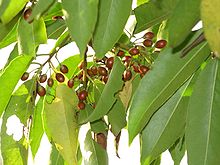| Ilex chinensis | |
|---|---|

| |
| Fruit and foliage | |

| |
| Bole | |
|
Scientific classification
| |
| Kingdom: | Plantae |
| Clade: | Tracheophytes |
| Clade: | Angiosperms |
| Clade: | Eudicots |
| Clade: | Asterids |
| Order: | Aquifoliales |
| Family: | Aquifoliaceae |
| Genus: | Ilex |
| Species: | I. chinensis
|
| Binomial name | |
| Ilex chinensis | |
| Synonyms [1] | |
|
List
| |
Ilex chinensis (syn. Ilex purpurea), the Kashi holly, oriental holly, or purple holly, is a species of flowering plant in the family Aquifoliaceae, native to Vietnam, southern China, Taiwan, and central and southern Japan. [1] [2]
Uses
It is one of the 50 fundamental herbs used in traditional Chinese medicine, where it has the name dōng qīng ( Chinese: 冬 青). In traditional Chinese medicine, it is said to promote circulation, remove stasis, and clear heat and toxins. It is believed to improve conditions such as angina, high blood pressure, uveitis, coughs, chest congestion, and asthma. The root of Ilex purpurea can be applied topically to skin infections and burns, and to wounds. [3] It has found use as a street tree in a number of Chinese and European cities. [4]
References
- ^ a b "Ilex chinensis Sims". Plants of the World Online. Royal Botanic Gardens, Kew. Retrieved 25 October 2022.
- ^ "Ilex chinensis". North Carolina Extension Gardener Plant Toolbox. N.C. Cooperative Extension. 2022. Retrieved 25 October 2022.
- ^ "Ilex (mao dong qing)". www.acupuncturetoday.com. 2019-02-01. Retrieved 2021-12-29.
- ^ Ossola, Alessandro; Hoeppner, Malin J.; Burley, Hugh M.; Gallagher, Rachael V.; Beaumont, Linda J.; Leishman, Michelle R. (2020). "The Global Urban Tree Inventory: A database of the diverse tree flora that inhabits the world's cities". Global Ecology and Biogeography. 29 (11): 1907–1914. Bibcode: 2020GloEB..29.1907O. doi: 10.1111/geb.13169. S2CID 225429443.